Mural Key
The mural is designed in the shape of a breast. Each sector of the mural reveals as much about breast cancer as about the broader social conditions and challenges that confront underserved women.
The Root of The Problem
The two monochromatic sections at the bottom of the mural present environmental dangers linked to cancer. The images represent environmental racism which allows our government and corporations to disproportionately target commuities of color and low income communities for waste disposal and siting of polluting industries ---- endangering the health and well being of all our lives.
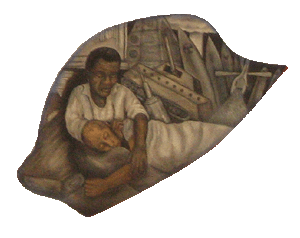 |
Right lower sector:In the foreground, a man cradles a dying woman whose death is linked to polluting power plants, toxins and poisons from chemical spraying and skewed priorities of a government that spends billions on military weapons, taking money away from health care and other human services. |
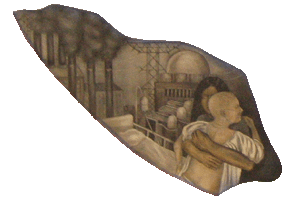 |
Left lower sector:A woman holds a dying woman beside her hospital bed. Behind them lies the landscape of toxic pollution: nuclear power plants, giant electric transmitters, refineries and incinerators emitting toxic chemicals known to cause cancer and other health problems. |
Women Together
Women's breasts are a source of nourishment for human life. Here the nipple, or areola, becomes a circle of women from around the world gathered to nourish one another by providing support and sharing understandings that will lead to solutions.
Central lower sector:
The Angel, hovering near the women, reminds us that those whom we have lost are present, those who are remembered live on.
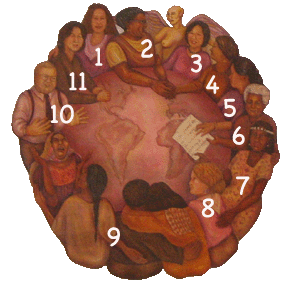 |
1) Darlene Garcia, Portuguese-American Action Researcher with the BCOHAP. Darlene interviewed Mary Jackson. 2) Mary Jackson, African-American breast cancer survivor of Oakland, California, Mary led a support group for African-American women through the Women's Cancer Resource Center (WCRC). 3) Thoa Nguyen, Vietnamese health educator and activist with The Vietnamese Community Health Promotion Project in Oakland, California. 4) Carol Finnis, African-American breast cancer survivor. |
5) Gin Lein Bergamn, Chinese Action Researcher with the BCOHAP. The paper in front of her reads: "We, women of the world, in seeking the health and well-being of our communities..."
6) Vickie Garvin, African-American social justice activist, stepmother of the muralist, Miranda Bergman.
7) Essie Mormon, African-American breast cancer survivor and activist, Essie worked against environmental racism in San Francisco.
8) Catherine Guerra, a white woman, breast cancer survivor and activist researcher.
9) The next four women hold each other in comfort as they listen to stories of one another's pain as a part of their healing.
10) Margo Rivera-Weiss, a queer artist, is the Community Outreach Manager and Art Gallery Coordinator at the Women's Cancer Resource Center (WCRC) in Oakland, California. The WCRC has played a leading role in political education and action that links environmental pollution to cancer. WCRC has a library and provides direct services and support groups to women with cancer and their families.
11) Grace Liu, Chinese Action Researcher with the BCOHAP. Grace interviewed Gin Fong.
Mirrors
When we hold the mirror up to the realities of breast cancer what do we see? Who holds the mirror? What images, stories, and experiences are reflected back?
Left central sector:
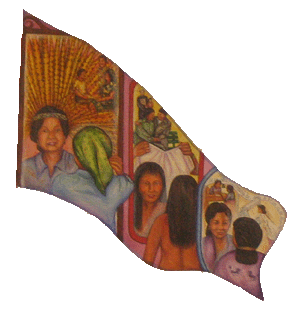 |
(Left) Maria Nakata, Mexican Action Researcher with the BCOHAP, pictures herself as an Azteca, proud of her "cultura" and her role with the BCOHAP. She interviewed Ofelia Flores, breast cancer survivor from Mexico, who tells the story of her cancer and mastectomy 20 years ago. Pictured also is Ofelia's husband, Fidel, who has stood by her through her diagnosis, treatment, and healing. (Center) A Chinese woman looks into the mirror of longevity. Confronting death with the traditional tearing of white cloth and celebrating age through the image of Grace Liu's grandmothe, shown here wearing a "long life" dress. |
(Right) An older Vietnamese immigrant, a manicurist, suggests the connection between the toxic fumes she experiences on her job and an increased risk of breast cancer. She is shown here getting a mammogram.
Right central sector:
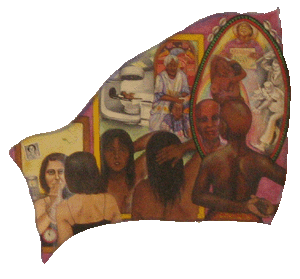 |
(Right) An African-American breast cancer survivor, sees herself as a woman with many identities: a lesbian, a woman trying to heal her body while pursued by insurance companies and doctors wanting money, and an activist who pays tribute to Fannie Lou Hamer, the great African American civil rights activist who died of cancer in 1977. In this mirror, unlike in her world, many identities are revealed. (Center) An indigenous woman, during breast self exam, considers her choices for healing, including radiation and a traditional laying on of hands. She asks us to question the choices women have in responding to a diagnosis of breast cancer and who has access to choices. |
(Left) Beth Sauerhaft, Founder of The Breast Cancer Oral History Action Project, in a Jewish tradition, remembers with a yortsite candle the death of her Aunt Dyna from breast cancer and the secrecy surrounding her aunt's diagnosis. With one hand Beth moves to break the silence about breast cancer. The mirror is cracked, but through the cracks leafy tendrils are growing. Out of brokeness, new life springs----the BCOHAP is an expression of that.
Collective Action: An Army Of One-Breasted Women
Left top sector:
Here, an army of one-breasted women and their allies move to raise awareness of breast cancer and the environmental links to cancer. The placards suggest a range of social justice issues that must be part of the struggle. Men light candles in solidarity.
The row of headstones helps us remember all those we have lost. Names on the headstones include:
Pat Parker, African-American lesbian poet, died of breast cancer in 1989.
Nora Astorga, lawyer and leader in the Sandanista revolution in Nicaragua, died of breast cancer in 1989.
Jackie Winnow, founder of The Women's Cancer Resource Center in Berkeley, CA (WCRC), died of breast cancer in 1991.
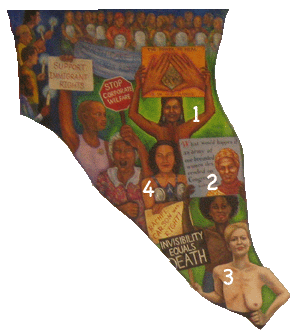 |
1) Wanda Green raising the sign: "The Power to Heal is in Our Hands". An African American woman, Wanda was diagnosed with breast cancer at age 29, following the birth of her 7th child. Wanda also battled drug addiction. She generously shared her story with the BCOHAP. 2)
Audre Lorde, internationally
known African American lesbian,
writer of poetry and prose
who politicized her struggle
with breast cancer. She
appears in a placard with
a quote from The Cancer
Journals: "What would happen
if an army of one-breasted
women marched upon Congress....". 3) Ravenlight, white lesbian breast cancer survivor, exhibitionist/activist, body worker.
|
4) Diana
Avila, shared her experience of
breast cancer with The Breast
Cancer Oral History Project. An
activist, lesbian, liberation
theologian and single mother from
El Salvador, the gas mask on her
breasts represents both protest
and protection. The sign she holds
reads, "Rachel Carson was right".
Rachel Carson, author of Silent
Spring and founder of the environmental
movement, died in 1964 at age
56.
Diana Avila lost her battle with
breast cancer in 2000. Prior to
Diana's death she thanked the
BCOHAP for 'giving voice to those
of us who carry in our bodies,
the consequences of an environment
polluted with chemicals".
Collective Action: Fighting Environmental Racsism
Right top sector:
Communities of color, women, men, youth and their allies come together to fight pesticides, toxic waste and nuclear weapons, to "stop cancer where it starts." Similar protests successfully prevented the location of a power plant in the Bayview Hunters Point community of San Francisco, CA. Images include many activists from this largely low-income African American community with disproportionately high rates of breast cancer.
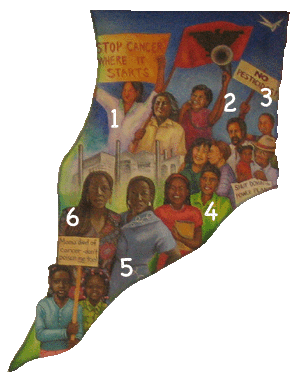 |
1) Fam Saechao,at the time a high school student and youth leader with the Asian Pacific Environmental Network, Laotian Organizing Project, and Creek Keepers in Richmond, CA. Fam's aunt had breast cancer. 2) Ray Tompkins, African-American environmental activist and scientist. 3) Jessica Govea Thorbourne, Chicana activist, labor educator, founding member of the United Farm Workers Union, died of breast cancer in 2005 at the age of 58. 4) Norma Williams, African-American breast cancer survivor. |
5) Francine Carter, African American activist with Bayview Hunters Point Health and Environmental Assessment Task Force.
6) Frances Carter, nurse and twin sister of Francine.
Hope For the Future
Displayed here are images of what we can do individually and as a society to build a healthier life for ourselves and our communities. These include honoring the struggles of indigenous people, creating music, cultivating organic gardens, nurturing our children, and self-education.
Center top sector:
Butterflies are said to be spirits of those who have passed on according to the folk cultures of Mexico, Ireland, Siberia and ancient Greece.
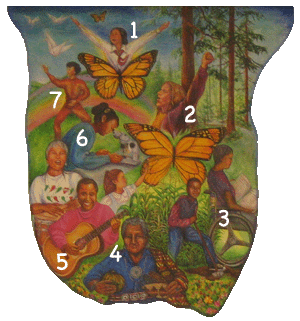 |
1) Sadako Sasaki rises out of the butterfly at the top of the mural. A Japanese girl who died in 1955 at the age of 12 of leukemia caused by atomic bombs the U.S. dropped on Hiroshima during WW II, Sadako lives on through the image of the paper crane, now an international symbol for peace. 2) Judi Bari, leader in social and environ- mental justice movements including Earth First! and the campaign to save the Headwaters Forest died of breast cancer March 2, 1997. |
3) The woman in the wheelchair reads a bilingual book about environmentally safe cleaning products.
4) Katherine Smith, Dineh (Navajo) resister, active in the struggle against uranium and other mining at Big Mountain in Arizona.
5) Regina Barr, African American breast cancer survivor.
6) Nieshia Harrison, shown here at age 13, daughter of breast cancer survivor Wanda Green, looks into a microscope, reminding us to encourage young women of color to become our scientists.
7) Jenny Chen, Chinese Action Researcher with BCOHAP, pictured in a Tai Chi stance.
* The Mural Key was originally written in 1998. When known, some revisions have been made to reflect the tragic deaths of some of the women with breast cancer who participated in The Breast Cancer Oral History Action Project.


